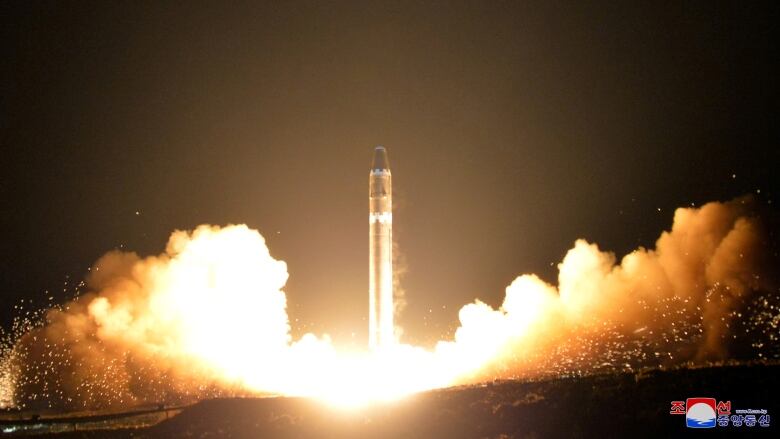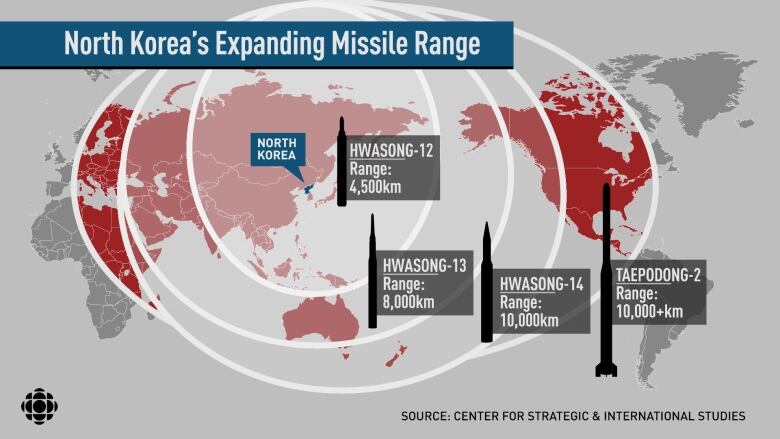'Just a matter of time': North Korea's missile capabilities may be closer than once thought
'We've laughed at them for a long time, but they're pretty good at this,' expert says

On Tuesday, North Korea launched a missile it says has the ability to reach the continental United States, and experts believe that could be a real possibility.
There are many unknowns about the technology the highly secretive country possesses. However, its decades-long work to increase its nuclear capabilities, including developing intercontinental ballistic missiles (ICBMs), should now be taken seriously, some say.
"It's just a matter of time ... for them to have a working ICBM with a hydrogen weapon on it," Ian Williams, associate director of the International Security Program at theCenter for Strategic and International Studies, toldCBCNews. "Welaughed at them for a long time, but they're pretty good at this."
While the missile went farther than any other, it's not an entirely new rocket,David Wright, a physicist and missile expert from theUnion of Concerned Scientists, toldCBCNews.
- Why it's so tricky to figure out what North Korea is up to
- U.S. plans extra sanctions against North Korea
- North Korea threatens to 'sink' Japan
"From a technical standpoint, this was a logical next step beyond what North Korea did in July," he said, referring to the launch of aHwasong-14ICBM that experts saidwould be capable of reachingLos Angeles. "But I would have actually called this the Hwasong-14.1 rather than the Hwasong-15."

The challenges of distance
While experts believe that it's unlikely North Korea has yet the ability to launch a hydrogen bomb, Williams said they likely have weaponizable atomic technology. And those could be put on short-range missiles capable of reaching South Korea and Japan.
Tuesday's launch was said to have carried the missile to an altitude of4,500 kilometres more than 10 times that of the International Space Station. If so, it was the highest and longest missile launch in the country's history.
It's not known what kind of payload was used, but whatever it weighed, Williams estimates the Hwasong-15 could reach all of North America.

However, all that is thrown into question if the payload the nuclear warhead itself is much heavier than whatever thepayload was for Tuesday's launch.Experts agree that a typical warhead might weigh somewhere between half a ton and oneton. If it was a light payload on Tuesday, as some believe something like 100-200 kg thenreplacing it with a half-tonwarhead could cut the range by a third, Wright said.
"One of the things you're trying to do is to make that as light as possible," he said. "And that's the real question: Is North Korea at half a ton? Some of us think they may be able to get down to a third of a ton."
That is a scary thought to Williams.
"If they did have a warhead, speculatively, that was about 300 kg, that would be a big deal. That would be pretty bad," he said.
'They're going to get there'
The missile's trajectory also plays a large part in determining the distance it can travel. The one used on Tuesday, Williams notes, is a "lofting trajectory," where it goes straight up and returns nearby. It's akin to a pop fly in baseball. On that particular trajectory, it has less resistance on the way down.
But in order to get it to North America, it would have to travel more like a home run,more or less diagonally. This would, in turn, increase the stress on the vehicle which means a more durable vehicle would be required.

Another unknown is whether or not North Korea has thetechnology to protect the re-entry vehicle that would house the warhead. That part might be the easiest to achieve, Williams said.
Though North Korea's missile program has been going on for decades, Wright said they seem to be getting closer in recent years.
"They might not be going fast; it might be taking them some time. But they're going to get there."













_(720p).jpg)


 OFFICIAL HD MUSIC VIDEO.jpg)
.jpg)



























































































